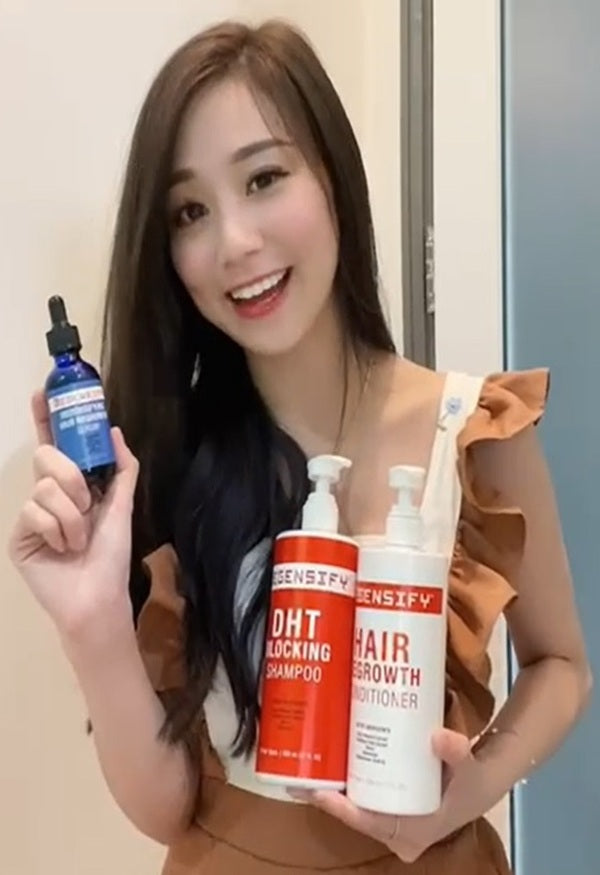WELCOME TO REGENSIFY
WELCOME TO REGENSIFY
Products
REGENSIFY Bodycare Collection

REJUVENATE YOUR BODY WITH REGENSIFY
REGENSIFY Eyecare Collection
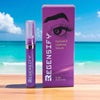
REDENSIFY YOUR LASHES AND BROWS WITH REGENSIFY
REGENSIFY Haircare Collection
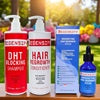
REDENSIFY YOUR HAIR WITH REGENSIFY
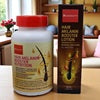
REVERSE GREY HAIR WITH REGENSIFY
Bundles
Tyrosine and Grey Hair — Oral vs Topical Solutions
September 15, 2025 4 min read

Grey hair often starts when pigment cells (melanocytes) slow down their production of melanin. One of the most important ingredients in this process is L-Tyrosine, an amino acid that serves as the raw material for melanin synthesis. But how you deliver tyrosine — orally as a supplement or topically through advanced formulas — can make a big difference.
Oral L-Tyrosine: Feeding the Body from Within
Oral L-Tyrosine works by providing the body with the substrate needed to build melanin. Once absorbed, it supports:
-
Melanin Production – Tyrosine is converted into melanin through the action of the enzyme tyrosinase.
-
Stress Resilience – Tyrosine also plays a role in producing neurotransmitters like dopamine and norepinephrine, which can buffer stress — a factor linked to premature greying.
-
Systemic Support – Because it circulates through the bloodstream, oral tyrosine nourishes every follicle evenly.
👉 Limitation: Oral tyrosine requires active melanocytes and functioning tyrosinase. If pigment cells are depleted (common in long-standing grey hair), tyrosine alone won’t restart melanin production.
Topical Tyrosine: Direct Delivery to Hair Follicles
Topical formulations apply tyrosine derivatives directly to the scalp, where pigment loss occurs. Two notable cosmetic actives include:
-
Darkenyl® – A patented complex that combines N-Acetyl-Tyrosine with antioxidants (like Naringenin). It supplies tyrosine directly at the follicle while protecting melanocytes from oxidative stress.
-
MelanoGrey® – Another cosmetic active featuring N-Acetyl-Tyrosine plus protective compounds designed to fight hydrogen peroxide buildup (a known driver of greying).
👉 Advantage: By applying tyrosine precursors right at the follicle, topical products bypass the digestive system and target melanogenesis locally. This can be particularly useful for early grey hair or people seeking non-oral solutions.
Oral vs Topical: Which Is Better?
-
Oral Tyrosine: Best for systemic support, ensuring the body has enough raw material for melanin production. Works well in combination with melanocyte-activating ingredients like Melatine®.
-
Topical Tyrosine: Directly targets the follicle environment, combining tyrosine precursors with antioxidants to protect and stimulate pigment cells.
💡 The Smart Approach: Combine both. Oral supplementation such as the REGENSIFY Hair Melanin Booster Nutrition with 200 mg L-Tyrosine ensures internal supply, while topical N-Acetyl Tyrosine formulas (Darkenyl®, MelanoGrey®) such as the REGENSIFY Hair Melanin Booster Lotion help optimize the follicle microenvironment.
The Limitation of L-Tyrosine
While L-Tyrosine is a key building block for melanin, its effectiveness depends on the activity of tyrosinase, the enzyme that converts tyrosine into pigment. If tyrosinase levels are low, extra tyrosine alone won’t produce more melanin. Tyrosinase activity can decline due to aging, oxidative stress, poor nutrition, or genetic factors, which is why hair that has been grey for years may be harder to restore. To support tyrosinase activity, it helps to protect hair follicles from oxidative stress (antioxidants like Coenzyme Q10), maintain adequate mineral intake (copper is a key cofactor for tyrosinase and zinc is essential for tyrosinase activity), and ensure overall follicle health through good nutrition and targeted ingredients like Melatine®, which stimulates melanocyte function. Hair that has been grey for a long time is harder to restore, because melanocyte activity may be diminished and tyrosinase activity may be low. L-Tyrosine is necessary but not sufficient. Its effectiveness depends on enzyme activity, antioxidants, mineral cofactors, and overall follicle health. Without supporting tyrosinase and melanocytes, extra tyrosine won’t reverse grey hair effectively. Therefore, it is important to treat your grey hair as early as possible before it gets worse.
Zinc and Copper: Key Players in Hair Pigmentation
Melanin, the pigment that gives hair its colour is produced through this pathway:
Tyrosine → DOPA → DOPAquinone → Melanin
This conversion is controlled by the enzyme tyrosinase, which is copper-dependent but also requires zinc to function properly.
Zinc: the maintenance oil 🛠️
Zinc helps keep tyrosinase stable and properly structured. Without enough zinc, the enzyme becomes less active, meaning tyrosine (even if abundant) cannot be efficiently converted into melanin.
Copper: the spark plug ⚡
Copper is the actual cofactor that drives the enzymatic reaction. It powers tyrosinase, enabling the chemical steps that turn tyrosine into pigment.
Why This Matters for Greying Hair
-
Tyrosinase activity naturally declines with age.
-
Oxidative stress in hair follicles — especially hydrogen peroxide buildup — can further inhibit the enzyme.
Actives like Darkenyl® contain zinc chloride support tyrosinase, ensuring both the “oil” (zinc) and “spark plug” (copper) are in place to keep melanin production running smoothly. Darkenyl® is also one of the key actives found in REGENSIFY Hair Melanin Booster Lotion.
The 15 mg zinc to 1 mg copper ratio in REGENSIFY Hair Melanin Booster Nutrition provides a balanced supplementation strategy to maintain and activate tyrosinase efficiently.
In simple terms:
-
Tyrosine = raw material 🧱
-
Tyrosinase = machine ⚙️
-
Zinc = maintenance oil 🛠️
-
Copper = spark plug ⚡
Without either zinc or copper, the melanin “machine” stalls — tyrosine can’t be converted into pigment, and hair loses its natural color.
REVERSE GREY HAIR WITH REGENSIFY
DOWNLOAD Anti Grey Hair Product Catalog
DOWNLOAD Anti Grey Hair Clinical Study
Disclaimer: All brand names and trademarks mentioned are the property of their respective owners. This article is intended for educational and informational purposes only, based on publicly available data and clinical studies.
Leave a comment
Recent Articles
-
Dutasteride vs Finasteride vs Oral Minoxidil: Latest Insights for Male Pattern Hair Loss
October 07, 2025
-
Kordel's vs REGENSIFY vs Trichoderm: The Ultimate Melatine Supplement
September 24, 2025
-
Battle of the Anti-Grey Titans: REGENSIFY Lotion vs Trichoderm Serum
September 22, 2025
-
Melatine®: The Black Sheep Secret to Fighting Grey Hair Naturally
September 20, 2025
-
The Ultimate Anti-Grey Trio: Greyverse + Darkenyl + MelanoGray. Repair, Fuel and Protect.
September 19, 2025
-
Darkenyl + MelanoGray: Double Defense Against Grey Hairs
September 16, 2025
-
Tyrosine and Grey Hair — Oral vs Topical Solutions
September 15, 2025
-
Hair Growth vs Hair Colour: Can Minoxidil Trigger Premature Greying? A new study suggests the answer is a YES.
September 13, 2025
-
Synergy: Adenosine and Coenzyme Q10: How They Help Prevent Grey Hair
September 10, 2025
-
REGENSIFY VS VIDA GLOW - Which AnaGain™ Nu formula works best to prevent hair loss?
September 01, 2025
Latest REGENSIFY Blog Posts
Share this product
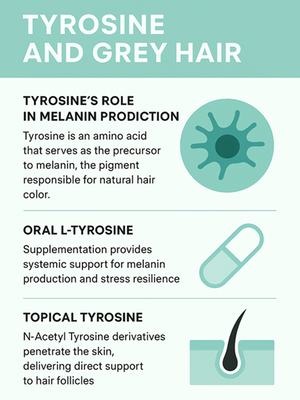
Tyrosine and Grey Hair — Oral vs Topical Solutions
Discover Tyrosine, zinc, & copper work together to support melanin. Combine both Oral and Topical REGENSIFY Hair Melanin Booster together for maximum benefits.
